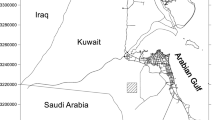Abstract
In Bahrain, where water resources available for direct use are finite and the best of its quality has a salinity of over 2.5 g L−1, utilization of brackish groundwater is an essential part in the management of the country's water resources. Bahrain's brackish water occurs in the Rus-Umm Er Radhuma formations in the form of a lens of a finite lateral extent, with a salinity ranges between 8 and 15 g L−1. Planning for utilization of brackish groundwater for desalination purposes in Bahrain was based on simulation modeling of the aquifer system using a mixing cell model developed originally in 1983. The model was used to predict the aquifer response to pumping from the proposed wellfield in terms of changes of TDS over a period of 20 years. Construction and operation of the wellfield in 1984 was based on the predicted salinity changes. Over the past 9 uears of wellfield operation (1984–1993), and through continuous monitoring of the aquifer response to pumping, the collected data is used to post-audit the original model by history matching. The calibration process adopted has resulted in a statisfactory agreement between the model output and the observed data. The model is then used to predict the wellfield salinity changes and the aquifer potentiometric levels. The expected life span for the brackish groundwater utilization by the wellfield is redefined through constrained utilization that takes into account salinity deterioration coupled with the effect of head decline on hydraulic interaction between the brackish water and the upper fresh water aquifer. The results suggest that the operation of the wellfield should cease by the year 2007. Construction of a new model that enables testing and evaluating different development scenarios is recommended to aid future management decisions regarding the utilization of brackish groundwater.
Similar content being viewed by others
References
Dannish, S. A. and Al-Ansari, M. A., 1991, MSF vs RO — An Economical comparison study,Proc. IDA World Conf. Desalination and Water Reuse, 25–29 August 1991, Washington, D.C.
GDC (Groundwater Development Consultants), Umm Er Radhuma Study, Bahrain Assignment, Volume III: Groundwater Resources. Ministry of Commerce and Agriculture, Bahrain.
GDC 1983a, Project 25/81, Reverse Osmosis Desalination, Groundwater Model Studies, Volume I: Main Report. Ministry of Works, Power and Water, Bahrain.
GDC, 1983b, Project 25/81, Reverse Osmosis Desalination, Groundwater Model Studies, Volume II: Extended Regional and Aquifer C Models. Ministry of Works, Power and Water, Bahrain.
Zubari, W. K., 1987, A numerical three-dimensional flow model for the Dammam aquifer system, Bahrain and Eastern Saudi Arabia, Chapter III: Climate and surface water. M.Sc. thesis, Department of Earth Resources, Ohio University, Athens OH.
Zubari, W. K., Aman, A. M., and Madani, I.M., 1993, Development impacts on groundwater resources in Bahrain,Water Resour. Develop. 9, 263–279.
Author information
Authors and Affiliations
Rights and permissions
About this article
Cite this article
Zubari, W.K., Khater, A.R. Brackish groundwater resources in Bahrain: Current exploitation, numerical evaluation and prospect for utilization. Water Resour Manage 9, 277–297 (1995). https://doi.org/10.1007/BF00872488
Received:
Accepted:
Issue Date:
DOI: https://doi.org/10.1007/BF00872488




